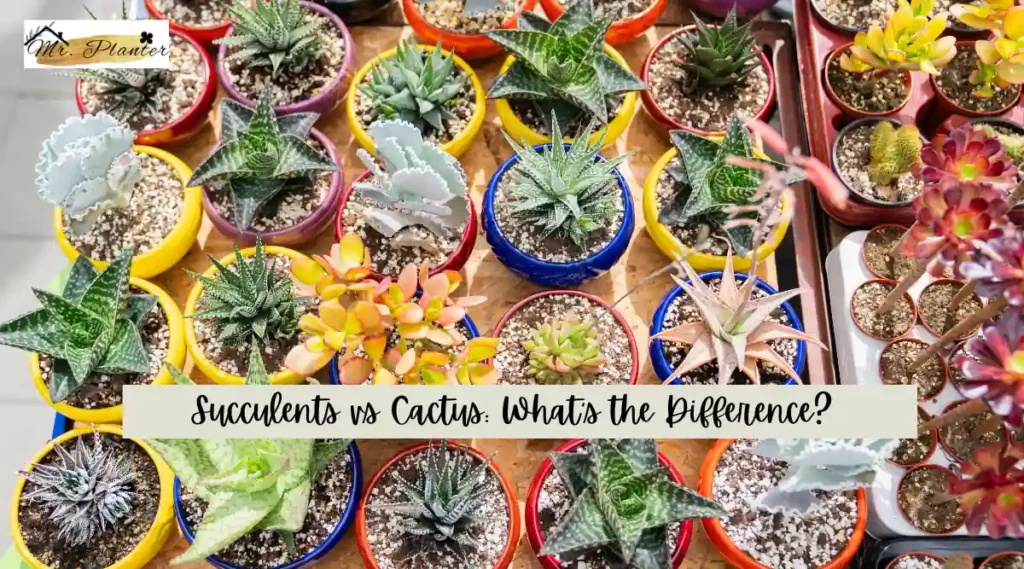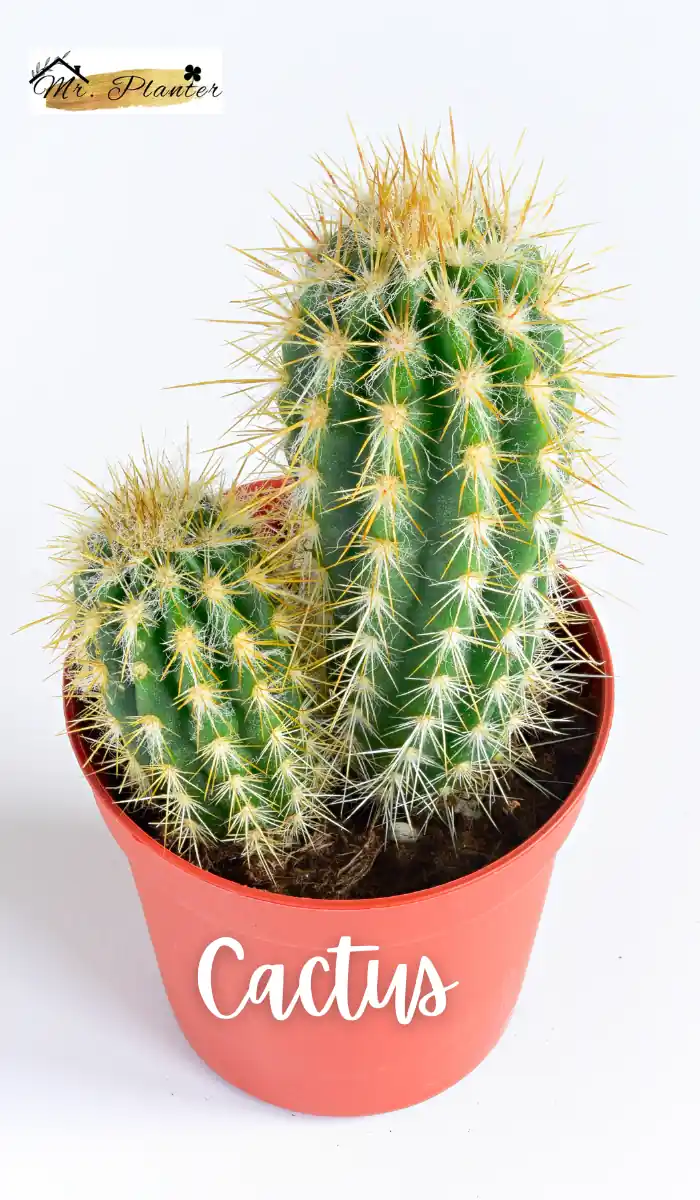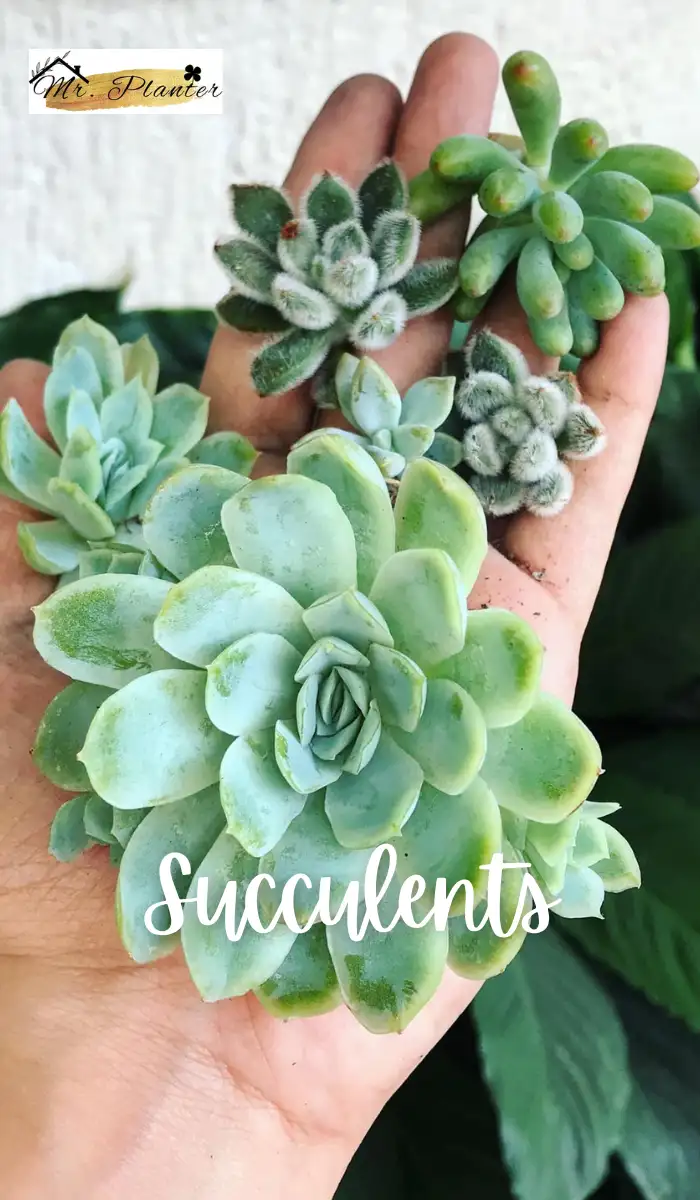In the world of plants, succulents and cacti stand out for their unique and captivating characteristics.
Both belong to the family of drought-resistant plants, thriving in arid and semi-arid regions.
While they share some similarities, they also exhibit distinct features that set them apart.
This article delves into the world of Succulents vs Cactus, exploring their defining traits, care requirements, and differences.
Although all cacti are succulents, not all succulents are cacti. Cacti are a particular subset of succulents that possess distinctive physical characteristics and areoles. In contrast, succulents comprise a wider variety of plants that have diverse adaptations for water storage.

Let’s get started!
Difference Between Cacti and Succulents
| Feature | Cactus | Succulent |
|---|---|---|
| Areoles | A cactus has areoles, which are small, cushion-like structures that produce spines, flowers, and fruits. | A succulent does not have areoles, but may have spines or hairs on its surface. |
| Fruits | A cactus produces distinctive fruits, often called “cactus fruit” or “prickly pear”, which are edible and nutritious in some species. | A succulent produces fruits that vary in size, shape, and color, and may or may not be edible depending on the species and culture. |
| Propagation Methods | A cactus can be propagated by offsets, which are small plantlets that grow around the base of the parent plant. | A succulent can be propagated by various methods, such as leaf cuttings, stem cuttings, division, or seeds. |
What Are Cacti?
Cacti are a group of plants belonging to the family Cactaceae, renowned for their iconic appearance.
These plants have adapted to thrive in some of the most inhospitable environments, such as deserts and rocky terrains.

One of the most remarkable features of cacti is their unique ability to store water in specialized tissues, enabling them to survive extended periods of drought.
Some well-known examples of cacti include the Saguaro, Prickly Pear, and Barrel Cactus.
Cactus Care
Caring for cacti requires an understanding of their natural habitat. They prefer well-draining soil to prevent root rot, and their pots should have proper drainage.
Cacti thrive in bright sunlight and tolerate high temperatures, making them ideal for sunny windowsills or outdoor gardens.
Overwatering is a common mistake, as cacti prefer infrequent but deep watering.
A balanced fertilizer can be applied during their active growth period in spring and summer.
What Are Succulents?
Succulents, on the other hand, encompass a broader category of plants that possess the ability to store water in their leaves, stems, or roots.
This adaptation allows them to survive in environments with limited water availability.

Succulents come in various shapes, sizes, and colors, making them popular indoor and outdoor cultivation choices.
Echeverias, Aloe Vera, and Jade Plants are notable examples of succulents.
Succulents Care
Caring for succulents revolves around providing the right growing conditions.
Similar to cacti, they require well-draining soil and pots with adequate drainage. While succulents appreciate sunlight, some varieties thrive in partial shade.
Proper watering is crucial; allowing the soil to dry out between watering helps prevent root rot.
A diluted, balanced fertilizer can be applied during the growing season to promote healthy growth.
Physical Features:
Cacti and succulents have distinct physical features contributing to their unique appearances and adaptations. Cacti are characterized by their thick, fleshy stems that serve as water-storage organs.
These stems often have a segmented or ribbed structure, aiding in water storage and expansion during hydration.
The spines that grow from areoles, specialized structures on the cactus surface, are modified leaves.
These spines offer protection from predators and help reduce water loss by providing shade and reducing air movement around the plant.
Succulents, while also possessing water-storing tissues, exhibit a wide range of shapes and textures. Some succulents, like Echeverias, form rosettes of plump, water-retaining leaves that overlap to minimize water evaporation.
Others, such as Sedums, have trailing stems that root along the ground, effectively expanding their water-absorbing surface.
Certain succulents, like Jade Plants, develop thick, paddle-like leaves that store moisture for extended periods.
The diversity in succulent forms reflects their adaptation to various climates and water availability.
Flowering Difference:
The flowering patterns of cacti and succulents highlight another critical difference between the two groups.
Cacti often produce showy and colorful flowers that emerge from specific plant areas, often near or atop the areoles.
These flowers can be quite large and striking, attracting pollinators like bees, birds, and bats. Cacti have evolved unique floral structures to ensure successful pollination in their native habitats.
Succulents, while also capable of producing flowers, may have more inconspicuous blooms than cacti.
The flowering patterns of succulents vary widely depending on the species and environmental conditions.
Some succulents make small clusters of flowers, while others develop tall, elegant flower stalks.
The inconspicuous flowers of some succulents are often adapted to attract specific pollinators, such as moths or flies, which may differ from the pollinators of cacti.
Fruit Production:
Cacti and succulents differ in their fruit production and the significance of their fruits. Cacti are renowned for producing distinctive fruits, often called “cactus fruit” or “prickly pear.”
These fruits are not only visually appealing but also edible and provide a valuable source of nutrition in certain regions.
Cactus fruits, such as those from the Prickly Pear cactus, have a unique taste and are used in culinary applications, ranging from jams and jellies to beverages.
While succulents can also produce fruits, they may not be as widely recognized or consumed as cacti.
The fruits of succulents vary in size, shape, and color, and their consumption largely depends on cultural practices and local traditions.
In some cases, succulent fruits are edible and have medicinal or culinary uses, while in others, they may serve primarily as a means of dispersing seeds.
Propagation Differences:
Propagation methods highlight another distinction between cacti and succulents. Cacti are known for their offsets, small plantlets that grow around the base of the parent plant.
These offsets are genetically identical to the parent plant and can be easily separated and replanted to establish new individuals.
This propagation mode contributes to the clumping or clustering appearance often observed in cactus arrangements.
Succulents, on the other hand, exhibit a more comprehensive range of propagation methods.
Leaf cuttings involve detaching a healthy leaf from the parent plant and allowing it to develop roots and a new plant.
Stem cuttings involve taking a portion of a stem, letting it callus, and planting it to encourage root growth.
Division involves separating a mature plant into multiple sections, each of which can develop into an independent plant.
The choice of propagation method depends on the specific succulent species and its natural growth habits.
Lifespan:
The lifespan of Succulents and Cacti varies, and while both groups can include long-lived species, there are differences in longevity.
Cacti are renowned for their remarkable longevity, with some species capable of living for many decades or even centuries in their native habitats.
The longevity of cacti is a result of their adaptations to arid conditions, including water storage and efficient resource allocation.
Certain succulents, such as Sempervivums (known as “hen and chicks”), exhibit long lifespans and can thrive under the right conditions for several years.
However, the lifespan of succulents can vary widely depending on factors such as species, growing environment, and care practices.
Some succulents are short-lived, with a lifespan of only a few years, while others can persist for a considerable time with proper care.
Are Cacti Succulents?
Yes, all cacti are succulents. The term “succulent” refers to plants that have adapted to store water in their tissues, and cacti fit this description perfectly.
However, it is important to note that not all succulents are cacti. So, there are several succulents that are not Cacti.
The distinction lies in the unique characteristics, such as the presence of areoles (specialized structures from which spines, flowers, and new growth emerge) in cacti.
Frequently Asked Questions
Are succulents the same as cactus?
No, succulents and cacti are not the same. All cacti belong to the succulent family, but not all succulents are cacti. Cacti are a specific type of succulent that belong to the Cactaceae family.
Why are cactus called succulents?
Cacti are called succulents because they have the ability to store water in their thick, fleshy stems and leaves, which is a characteristic feature of succulent plants. The term “succulent” refers to plants that have specialized tissues for water storage, helping them survive in arid and dry conditions. Cacti exhibit this trait, making them a subset of the larger category of succulent plants.
Is a Succulent a Cactus?
Yes, a cactus is a type of succulent. Although all cacti are considered as succulents, not all succulents can be classified as cacti. Cacti are a specific group of succulent plants that belong to the Cactaceae family, known for their distinctive appearance, spines, and water storage capabilities.
Wrapping Up
Succulents and cacti have the remarkable ability to thrive in challenging environments, making them popular choices for plant enthusiasts and collectors.
While both groups possess water-storing adaptations, their physical features, flowering patterns, fruit production, propagation methods, and lifespans showcase their diversity.
Understanding these differences enables us to appreciate the rich and captivating world of succulents and cacti, each with unique charm.

